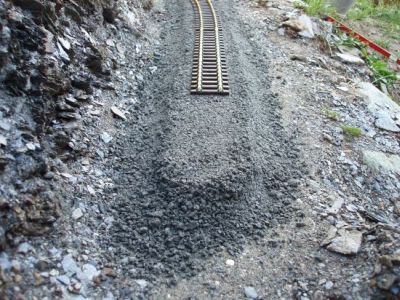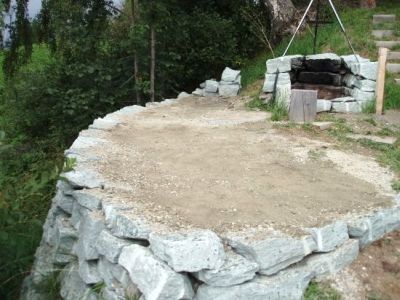|
|
|
Outdoor Display, Track Works, Layout
On the following track layout plan of the Moose Creek Line is recognized. Let's start right at the bottom of the picture: here is leaving the single-track line the porch and runs on the 18 ft long Moose Creek Trestle, which is about two thirds in the arch. After the Trestle, the route along the slope and disappeared in the tunnel east. Behind the tuft had a rockfall gallery be created because constantly loosen rocks from the rock wall and falling onto the tracks. In this area, I've moved around a 23 ft long siding.
In the short straight follows behind the crest of the canyon. Here, the track crosses Howe Truss Bridge with two elements of a ravine about 2 ft depth. All surrounded by a natural rock wall. After the canyon followed by a right turn inside the rock wall and then the tunnel portal of the tunnel west. In the tunnel there a switch for the double track section. The left portal of the tunnel, I have a Snow Gallery larch simulated the portal of the tunnel 41 at Donner Pass. (See page "PROTOTYPE RAILROAD", bottom "DONNER PASS")
After the tunnel, follow the double track of 180 ° left turn above a dry-retaining wall. Before the porch is reached, the rail tracks crosses two Plate Girder Bridges.
On the veranda, which runs along the south side around our house, returns the railway line to the east, to the Trestle. While in the middle of the veranda ends double track.

|
| |
|
|
 |
|
|
|
|
|
|
|
|
 |
|
Trackwork
First it is necessary to create an even and precisely in any possible gaps one Planum. In humus-rich soil, we recommend the move from floating mats.
The next step is sufficient gravel is distributed. (I use cohesive slate-granite gravel in the particle size to 5 mm.)
Thereupon I switch the tracks in the loose gravel. It is important that the track have no more power. When bending the track automatically go to the bends, so the tracks look perfectly after the final balast.
|
| |
|
|
 |
|
The finished piece of rail on the east side of the Trestle to the tunnel east.
Are the tracks balasted loose, regular Grampes is essential. In spring I turn each about a day, the Moose Creek line to make operational again. Whereby the loose laying of tracks in the balast has been well proven.
Under the slogan: look after the original and everything works! |
| |
|
|
 |
|
In this picture the gravel bed with a laid track is visible. Subsequently, the track must be balsted clean. For this I use a paintbrush and a small wooden pestle. |
| |
|
|
 |
|
Bulkhead at the beginning of the Trestle. Edge covering of larch wood resists weathering. |
| |
|
|
 |
|
Retaining wall of dry stone for the 180 ° turn on the west side of the railway line. After the fireplace, the tunnel portal of the tunnel west. |
| |
|
|
 |
|
Tunnel construction: First, create a Planum from cast concrete slabs. Then followed the tracks are screwed.
|
| |
|
|
 |
|
For the tunnel walls to create an arc of 5 mm Pavatex formwork panels that can be bent well. Then the walls are concrete, just to Pavatex amount of formwork that has the height of the tunnel walls. |
| |
|
|
In the left image below, the tunnel can be seen east of the finished concrete walls. The tunnel is then covered with strong plywood, covered with a waterproof film. This has the advantage that the "worst" case of tunnel cover and derailed trains can be salvaged. This would of course be associated with some excavation work, depending on how high the tunnel was covered.
The right picture shows the shell of the tunnel portal, tunnel West, which I have copied the portal of the tunnel 41 at the Donner Pass Line.
|
 |
|
 |
| |
|
|
Two pictures of the finished tunnel portal. |
|
|
 |
|
 |
| |
|
|
 |
|
Exit of the Coal Train, led by the big 2-8-8-2 steam locomotive from the West Tunnel. |
| |
|
|
Western and eastern portal of the tunnel west |
|
|
 |
|
 |
| |
|
|
|
|
|
|
For questions regarding the construction of a garden railway, send me an E-mail: themountaineer@bluewin.ch
I will help you in planning and can also actively support the building
|
| May 2010 / the mountaineer |
|
|
|
 |
|
|